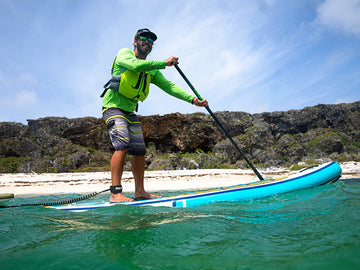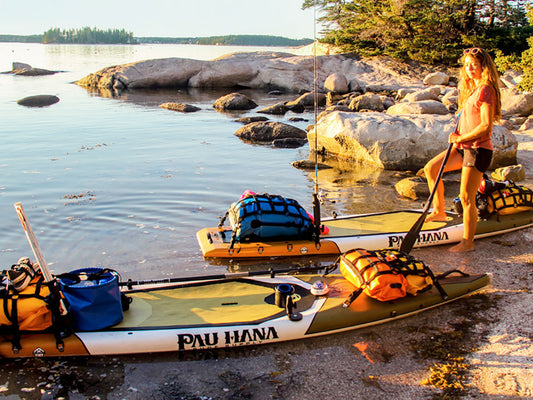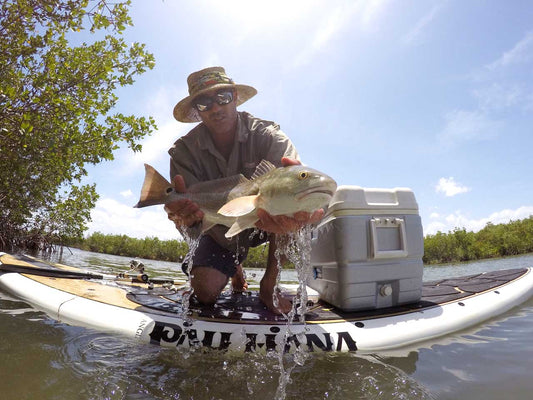Learn How to Select the Perfect PFD for a Safe and Enjoyable Paddleboarding Experience
When getting into stand-up paddleboarding (SUP), safety should always be the top priority. One of the most important pieces of safety equipment you'll need is a Personal Flotation Device (PFD). Often overlooked, the right PFD can be a lifesaver—quite literally. This guide will dive deep into the different types of PFDs, what to look for when choosing one, and how to ensure that it’s the right fit for your paddleboarding needs. Whether you’re a beginner or an experienced paddler, understanding how to select the right PFD can make all the difference in ensuring a safe, comfortable and enjoyable time on the water.
1. What is a PFD and Why Do You Need One?
A Personal Flotation Device (PFD) is a piece of safety gear designed to keep you afloat if you fall into the water. Even though paddleboarding is often done in calm waters, accidents can happen, and wearing a PFD can prevent drowning in situations where you become injured, tired, or are caught in strong currents or changing weather conditions.
Why It's Essential for Paddle Boarding
- Accidents Can Happen: Even the most experienced paddlers fall into the water. A sudden gust of wind, unexpected waves, or simply losing balance can knock you off your board.
- Safety in Unpredictable Conditions: Weather and water conditions can change rapidly. Calm water can quickly become turbulent, and a PFD can provide crucial buoyancy during such times.
- It Might Be Required by Law: In many regions, parks or areas, wearing a PFD is legally required, especially if you are paddling in open water or in areas with other water traffic. Not adhering to these regulations can lead to fines or more severe consequences in case of an emergency.
Wearing a PFD ensures that you can stay afloat, allowing you time to recover, swim back to your board, or wait for assistance if needed.
2. Different Types of PFDs for Paddle Boarding
There are several types of PFDs, each with its own pros and cons. Knowing the differences will help you choose the best option based on your paddleboarding environment and personal comfort preferences.
Type I: Offshore Life Jackets
Type I PFDs are designed for rough, remote waters where rescue might be delayed. These are the most buoyant and can turn an unconscious person face-up in the water.
- Best For: Open ocean paddling or extreme conditions.
- Downside: These tend to be bulky and may restrict movement, making them less ideal for casual paddleboarding and those seeking comfort.
Type II: Near-Shore Buoyancy Vests
These PFDs are a good choice for calm inland waters where rescue is quick. They offer less buoyancy than Type I but are lighter and less restrictive.
- Best For: Flat water or paddling close to shore.
- Downside: They may not turn an unconscious person face-up in the water.
Type III: Flotation Aids
Type III PFDs are the most commonly used for paddleboarding. They offer buoyancy but are designed to be more comfortable and less bulky. These vests give you the most freedom of movement, making them ideal for sports like paddleboarding, kayaking, or sailing.
- Best For: Recreational paddleboarding in calm to moderate conditions.
- Downside: Less buoyant than Type I and Type II, and they won’t turn you face-up if unconscious.
Type V: Special Use Devices
These are specific PFDs designed for activities like windsurfing, kayaking, or paddleboarding. They often have built-in features like harnesses or extra storage.
- Best For: Paddle boarders who want extra features tailored to their needs.
- Downside: They’re usually more specialized and may not offer the same buoyancy as general-use PFDs.
Inflatable PFDs
Inflatable PFDs are becoming more popular among paddle boarders because they are lightweight and compact. They can be worn around the waist like a belt or over the shoulders like a traditional life jacket. When you pull the activation cord, the PFD inflates, giving you the buoyancy you need. They are the least restrictive of all the PFDs.
- Best For: Calm, flat waters or when you need the least restriction while paddling.
- Downside: They must be inflated manually, which might not be ideal in emergency situations where you’re disoriented or unconscious.
3. Choosing the Right PFD: Key Features to Consider
Now that you know the types of PFDs available, it’s important to consider a few key factors when choosing the right one for paddleboarding.
1. Buoyancy
Buoyancy refers to the amount of lift the PFD provides to keep you afloat. PFDs are rated by their buoyancy in pounds, and most paddle boarders will need a vest that offers between 15.5 and 22 pounds of buoyancy. For calm waters, a lower buoyancy might suffice, but for rougher conditions or open water paddling, opt for a higher buoyancy vest. If your body weight is on the heavier side, opt for a vest with higher floatation.
2. Fit and Comfort
A PFD that doesn’t fit properly can be uncomfortable and less effective in keeping you safe. When choosing a PFD, make sure it fits snugly but allows you full range of motion for paddling. Women-specific PFDs are also available, designed with different torso shapes for a better fit. A comfortable PFD is more likely to get used than those that result in discomfort, make sure you shop around and try the different styles on to see which feels the most fitting for your body shape and paddling style.
- Adjustability: Look for a PFD with adjustable straps around the shoulders and sides to ensure a secure and comfortable fit.
- Range of Motion: Ensure that the PFD doesn’t restrict your arm or shoulder movement, as paddling requires full upper body mobility.
- Comfort: The padding and material should feel comfortable against your skin, without causing irritation through the paddle strokes.
3. Visibility
Brightly colored PFDs are not only a fashion statement but a safety feature. High-visibility colors like orange, yellow, or red make you more noticeable to boaters or rescuers in case of an emergency.
- Reflective Strips: Some PFDs come with reflective strips that improve visibility in low-light conditions, which is important if you’re paddleboarding early in the morning, late in the evening, or in low visibility weather like fog or rain.
4. Storage and Extra Features
Some PFDs come with built-in pockets that are perfect for storing small items like keys, snacks or sunscreen. While these extras aren’t essential, they can be useful for longer paddleboarding sessions.
- D-Rings: Some PFDs have D-rings where you can attach accessories like a whistle or waterproof bag.
4. Legal Requirements and Regulations
Before heading out on the water, it's important to be aware of local laws regarding PFDs. Many regions have specific regulations about wearing or carrying PFDs while paddleboarding, especially in areas with heavy boat traffic or open waters.
New Zealand PFD Regulations for Paddle Boarding
In New Zealand, paddle boarders are subject to specific regulations regarding the use of Personal Flotation Devices (PFDs). These regulations are designed to ensure safety on the water and are enforced by local maritime authorities.
NZ Maritime Law on PFDs
In New Zealand, Maritime Rule Part 91 (Navigational Safety Rules) governs the use of lifejackets, which includes PFDs for paddleboarding. The key points include:
- Carrying a PFD is Mandatory: All paddle boarders must have a PFD on board when paddling in open water. While the law does not specifically require the PFD to be worn at all times, it must be easily accessible in case of an emergency. However, wearing one at all times is recommended for safety.
- High-Risk Situations: If you are paddleboarding in areas where there are high-risk conditions, such as strong currents, boat traffic, or rough waters, wearing a PFD is mandatory. In these situations, you must wear your PFD rather than just carrying it onboard.
- PFDs for Children: Children under the age of 15 are required to wear a PFD at all times while paddleboarding, regardless of the water conditions or proximity to shore.
- Exemptions for Close Proximity: If paddleboarding within 200 meters of the shore in sheltered waters (e.g., calm lakes, bays), you may be exempt from the requirement to wear a PFD, although you should still carry one, and thus wear one.
5. PFD Care and Maintenance
To ensure that your PFD remains effective, proper care and maintenance are essential. A poorly maintained PFD can lose buoyancy, become damaged, or fail when you need it most.
After Each Use
- Rinse with Fresh Water: Saltwater can degrade the materials in your PFD. After each use, rinse it thoroughly with fresh water to prevent damage.
- Air Dry: Let your PFD air dry completely before storing it. Avoid placing it in direct sunlight for extended periods, as UV rays can break down the materials.
- Inspect for Damage: Regularly inspect your PFD for any rips, tears, or signs of wear. If you find any damage, it’s time to replace it.
Long-Term Care
Store your PFD in a cool, dry place. Avoid folding or compressing it for long periods, as this can compromise its buoyancy. Inflatable PFDs require special attention—check the CO2 cartridges regularly to ensure they’re still functional.
The Takeaway
Choosing the right PFD for paddleboarding is an important decision that can affect your safety, comfort, and overall enjoyment on the water. Whether you’re a beginner or an experienced paddler, having the proper PFD can give you peace of mind and ensure a safer paddling experience. By considering factors like buoyancy, fit, comfort, and visibility, you can find a PFD that suits your needs and keeps you protected, no matter where your paddleboarding adventures take you.





